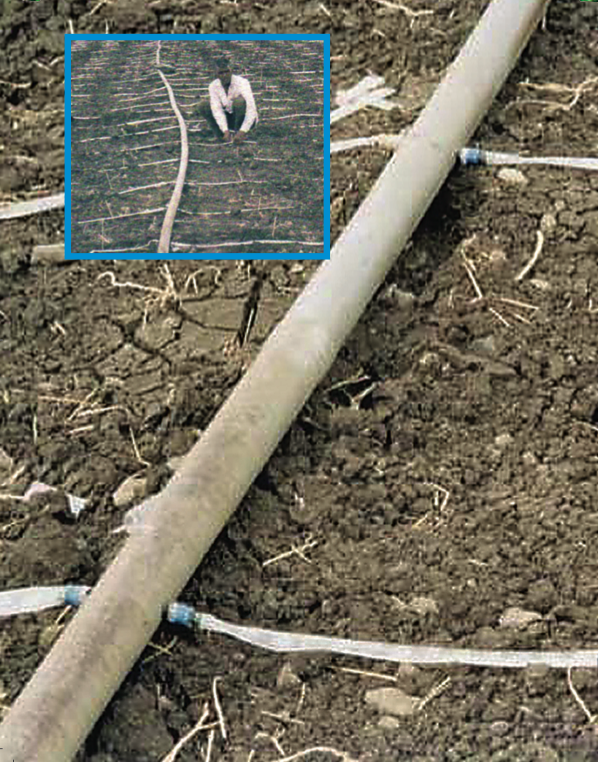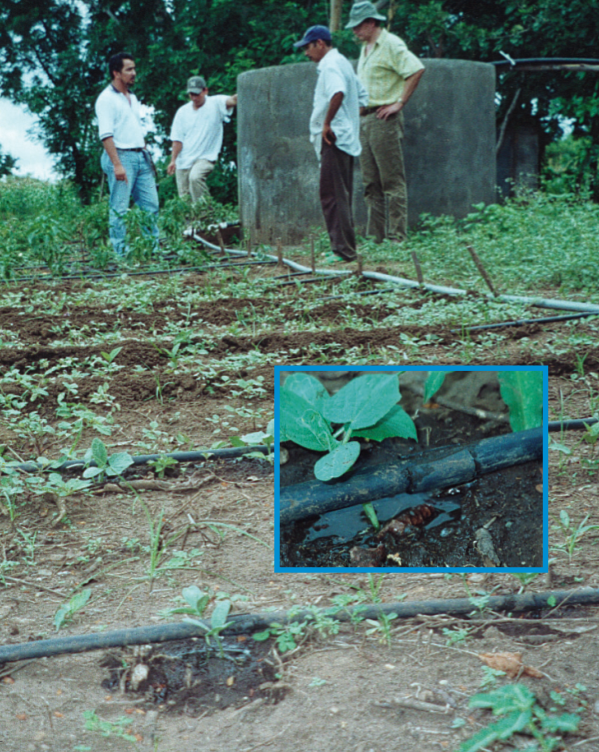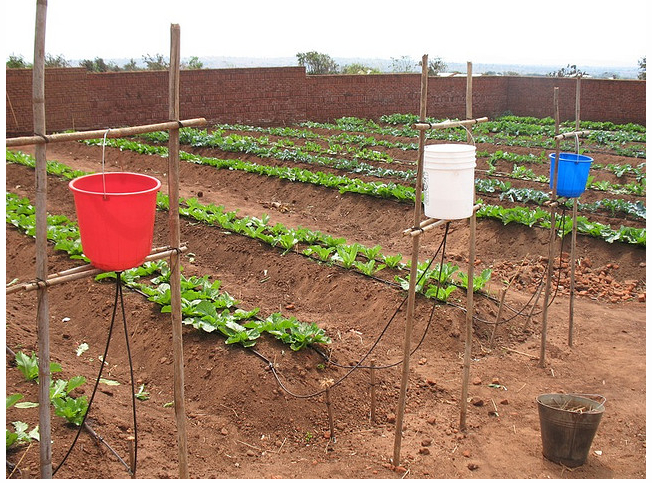Difference between revisions of "Drip Irrigation - Pepsi and Nica"
(→Construction, operations and maintenance) |
(→Construction, operations and maintenance) |
||
| Line 31: | Line 31: | ||
==Construction, operations and maintenance== | ==Construction, operations and maintenance== | ||
| − | [[Image:ChapinBucketSystem.jpg|thumb|right| | + | [[Image:ChapinBucketSystem.jpg|thumb|right|300px|The Chapin bucket drip system.]] |
Drip irrigation systems consist of water storage, water filtration, water conveyance and distribution, and water application sub-systems. Common preparation requirements and features are as follows: | Drip irrigation systems consist of water storage, water filtration, water conveyance and distribution, and water application sub-systems. Common preparation requirements and features are as follows: | ||
* Prepare the area to be irrigated. This could be simple land preparation or involve the formation of planting beds. | * Prepare the area to be irrigated. This could be simple land preparation or involve the formation of planting beds. | ||
Revision as of 02:14, 14 April 2012
Drip irrigation provides farmers the most efficient way to grow crops in water scarce areas through providing water at a controlled and regular rate to the root zone. Historically it has been too expensive for small-plot farmers, but now it is available at low cost and also adapted for small-scale farming and can reduce water losses by 30 - 70% when compared to conventional methods of crop irrigation, while greatly reducing labour and accurately delivering fertilizers. This makes cultivation during the dry season possible, with resulting yield increases of up to 30%.
To make drip irrigation affordable for small farmers, the Chapin bucket or IDE bucket and drum kits were developed and are now being promoted in many countries. A bucket kit costing US$ 5 can irrigate 25 m2 and a drum kit five times as much. Based on this principle, farmers in India started to make their own drip system, made of plastic hose that is normally used to package ice-lollies. Hoses can only be used for one growing season (generating plastic waste) but investment costs are so low that it is not a risk for poor families to invest in it. This technology now more or less promotes itself.
Easy drip irrigation is an improvement of the Pepsi drip that consists of sun resistant lay-flat hoses and micro tubes that have a lifetime of 1-2 years. This option is being developed by IDE and applied in Asia. Practica foundation is testing different options in Nicaragua, Tanzania, Zambia and Ghana.
Suitable conditions
- Drip irrigation is often the favoured method of irrigation, for example on steep and undulating slopes, for porous soils, for shallow soils, fields having widely varying soils, where water is scarce, where water is expensive, and where water is of poor quality.
- Drip irrigation is suitable for any plot under 0.4 hectare (one acre), but their modular design allows for expansion above that.
- The Pepsi drip has a capacity of 0.1 - 2 ha.
| Advantages | Disadvantages/limitations |
|---|---|
| - Reduces water consumption. - Uses commonly extruded plastic pipes, so low-cost systems are replicable in many countries. |
- Hoses have a short lifetime (generating plastic waste). - Possibilities of theft. |
Construction, operations and maintenance
Drip irrigation systems consist of water storage, water filtration, water conveyance and distribution, and water application sub-systems. Common preparation requirements and features are as follows:
- Prepare the area to be irrigated. This could be simple land preparation or involve the formation of planting beds.
- For best results, drip systems are used to irrigate level beds. If the drip tubes go uphill, downhill or around corners, the system will not give equal water flow from each dripping outlet.
- Construct the water container stand. Ensure that it can support the weight of the container and water when full.
- Mount the water container on the stand so that the water outlet is at the height necessary to provide the water pressure required to operate the system.
- Mount the container water outlet, water filtration and flow regulator fittings.
- Lay the water distribution system components that connect the water container to the individual drip lines. Make sure that the open ends are closed to avoid foreign material entering the pipe.
- Unroll the drip lines and lay them along the full length of each row of plants to be irrigated.
- Connect the drip lines with the water distribution system (header pipes).
- Flush the system to remove any foreign matter that may have entered the pipeline.
- Close the end of the drip lines.
It must be emphasized that any training or advice on the use of drip kit systems should not only cover actual kit installation and maintenance, but also all aspects of growing vegetables under drought conditions since the purpose is to increase farmers’ yields. Thus training and advice should include lessons about bed preparation and composting, transplanting, irrigation-water management and pest and disease control.
Save money and other considerations
Use the most economical system possible that will give results. iDE in Cambodia lowered the cost of drip systems by:
- Replacing conventional emitters with holes and micro tubes.
- Shifting water distribution lines extending to crops.
- Customizing system layouts for small plots.
- Reducing cost of water storage – the use of a hanging plastic water storage bag also lowers the cost. Experience shows that costs are reduced by three quarters by doing this, resulting in cost of about US$5 for a 200 litre bag that will cover 20 m2.
- The water tank capacity should be equal to one day retention of the daily water requirement. It should be placed at sufficient height to allow flow by gravity – approximately 1 metre height for an area of 100m2, 1.5 metres for 500 m2, and 2 metres for 1,000m2.
- Pipes vary in size and are made from varieties of polyethylene (PE) and soft PVC.
- The emitter is the most important part of a drip system because it delivers water at the desired rate to the plant and maintains water application uniformity over the entire irrigated area. An emitter should match particular field conditions including type of crop, spacing of the plants, terrain, water requirement, water quality, operating time and pressure head. At the same time, the emitters cause the most problems through blockages (particles, salts or algae) and need to be maintained.
- Try to bury main pipes underground to reduce visibility for theft.
Water management tips
- Maintain an optimum soil-moisture regime by applying the required amount of water at the right frequency. Shallow sandy soils require more frequent (1–2 day interval) irrigation; deep clay loam soils allow less frequent (3–7 day) irrigation.
- During the early stages of crop growth the plant roots are shallow and therefore there is a need for more frequent irrigation and less water per irrigation event.
- During the flowering or late vegetative stage of the crop, water consumption is highest so an adequate water regime is vital. Ensure that the crop does not experience moisture stress during this period.
- Crop water use will vary from 3 to 7 mm/ day. Ensure that adequate amounts (depending on the area and crop growth stage) are applied.
- All leaks should be mended quickly to prevent water wastage.
Maintenance
Ensure that only clean water is used in order to minimize the chances of clogging the filtration system. A filter screen will keep coarse particles from entering the drip lines. If there is fine silt in the water, or blowing sand in the air, a piece of cloth can be tied over the top of the bucket. Water can be poured through the cloth to keep the fine particles from entering the bucket.
- Clean the filtration system at least twice a month.
- Inspect the emitters to identify clogged emitters at least once a week and unblock or replace any clogged emitters. Clogged drip emitters cause non-uniform application of water and result in non-uniform growth of the plants.
- Flush the system at least once a month. The frequency can be increased or reduced depending on the amount of impurities in the irrigation water.
- Check and repair leaks frequently.
- Take extra care during field operations, particularly weeding, to avoid cutting the drip lines.
- Take precautions to minimize the destruction of drip lines by termites and rodents.
- When no longer in use, uninstall the components of the system and store them in a safe place.
Estimated Lifespan
1-2 years
Costs
- Cost/ha: Pepsi drip: US$ 60 (plastic hose only). Easy drip: US$ 200 400.
- Nica drip: (Nicaragua) US$ 300 to 600, depending on crop and material use.
- In Nepal, costs ranged between $0.11 and $0.17 per m2 of irrigated area, depending on the scale of irrigation.
Field experiences
- Zimbabwe study: Can drip irrigation improve the livelihoods of smallholders? Lessons learned from Zimbabwe.
Reference manuals, videos, and links
- This Drip Irrigation manual is set up by Arrakis.
- www.cgiar.org/iwmi
- www.ideorg.org
- www.practicafoundation.nl
Acknowledgements
- CARE Nederland, Desk Study Resilient WASH systems in drought prone areas. October 2010.
- Sijali, Isaya V. Drip Irrigation; Options for smallholder farmers in eastern and southern Africa. Sida’s Regional Land Management Unit, 2001.



